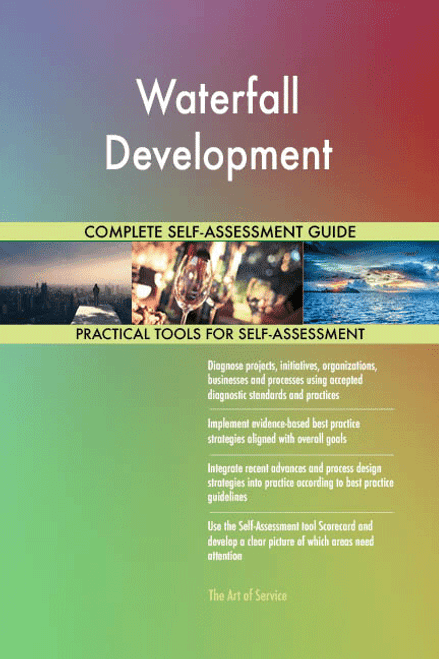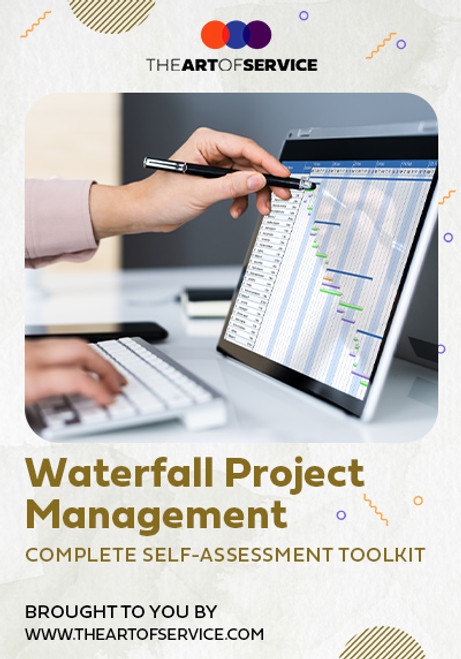Drive the creation of Solution Architecture models and patterns to reflect your organizations strategies and goals to deliver on business visions and goals.
More Uses of the Waterfall Model Toolkit:
- Arrange project/milestone in programming sequence.
- Control: remarkable service and personal leadership.
- Anticipate, challenge, and create.
- Drive: Software Engineering embedded development.
- Provide timely project deliverables based on implementation plan.
- Lean Process Improvement, Six Sigma, Agile implementation, Waterfall Model.
- Standardize: Interaction Design skills.
- Provide architecture and systems processing guidance ensuring the efficiency, security, and support of the Enterprise Architecture compliance.
- Develop and maintain financial Waterfall Models for Joint Venture investments.
- Execute various activities based on the Implementation methodology as Waterfall Model, ScruM And Agile as defined by the Technical Management.
- Lead design review and team retrospective meetings in order to continually iterate and improve as a team.
- Create project milestones, deliverables and timelines for implementation.
- Be the master of executing projects with quality.
- Evaluate: consistent exposure to end to end SDLC (Requirements Analysis, design, development management, testing and delivery).
- Establish and refine processes for maintaining and maturing the Design System.
- Be accountable for being able to develop effective User Interface using cutting edge technologies.
- Make sure that your venture leads the fundamentals in object oriented design, Data Structures, algorithm design, Problem Solving, and complexity analysis.
- Arrange that your group complies; DevOps and Software Development life cycle, Waterfall Model, Agile model, Continuous Integration and deployment.
- Ensure you realize high level Visual Designs and interactions to a production standard of UI design, ready to hand off to developers for implementation.
- Initiate: staff technical Project Management.
- Be accountable for manufacturing and production.
- Ensure you guide; understand, advocate, and augment the business and IT strategies and, more specifically, technology architecture development and delivery.
- Manage: Patch Management as a service.
Save time, empower your teams and effectively upgrade your processes with access to this practical Waterfall Model Toolkit and guide. Address common challenges with best-practice templates, step-by-step Work Plans and maturity diagnostics for any Waterfall Model related project.
Download the Toolkit and in Three Steps you will be guided from idea to implementation results.
The Toolkit contains the following practical and powerful enablers with new and updated Waterfall Model specific requirements:
STEP 1: Get your bearings
Start with...
- The latest quick edition of the Waterfall Model Self Assessment book in PDF containing 49 requirements to perform a quickscan, get an overview and share with stakeholders.
Organized in a Data Driven improvement cycle RDMAICS (Recognize, Define, Measure, Analyze, Improve, Control and Sustain), check the…
- Example pre-filled Self-Assessment Excel Dashboard to get familiar with results generation
Then find your goals...
STEP 2: Set concrete goals, tasks, dates and numbers you can track
Featuring 999 new and updated case-based questions, organized into seven core areas of Process Design, this Self-Assessment will help you identify areas in which Waterfall Model improvements can be made.
Examples; 10 of the 999 standard requirements:
- Why do and why don't your customers like your organization?
- Do you all define Waterfall Model in the same way?
- Who needs budgets?
- What is the craziest thing you can do?
- How are costs allocated?
- What are the necessary qualifications?
- How will you measure your Waterfall Model effectiveness?
- Has a Waterfall Model requirement not been met?
- When a disaster occurs, who gets priority?
- If there were zero limitations, what would you do differently?
Complete the self assessment, on your own or with a team in a workshop setting. Use the workbook together with the self assessment requirements spreadsheet:
- The workbook is the latest in-depth complete edition of the Waterfall Model book in PDF containing 994 requirements, which criteria correspond to the criteria in...
Your Waterfall Model self-assessment dashboard which gives you your dynamically prioritized projects-ready tool and shows your organization exactly what to do next:
- The Self-Assessment Excel Dashboard; with the Waterfall Model Self-Assessment and Scorecard you will develop a clear picture of which Waterfall Model areas need attention, which requirements you should focus on and who will be responsible for them:
- Shows your organization instant insight in areas for improvement: Auto generates reports, radar chart for maturity assessment, insights per process and participant and bespoke, ready to use, RACI Matrix
- Gives you a professional Dashboard to guide and perform a thorough Waterfall Model Self-Assessment
- Is secure: Ensures offline Data Protection of your Self-Assessment results
- Dynamically prioritized projects-ready RACI Matrix shows your organization exactly what to do next:
STEP 3: Implement, Track, follow up and revise strategy
The outcomes of STEP 2, the self assessment, are the inputs for STEP 3; Start and manage Waterfall Model projects with the 62 implementation resources:
- 62 step-by-step Waterfall Model Project Management Form Templates covering over 1500 Waterfall Model project requirements and success criteria:
Examples; 10 of the check box criteria:
- Cost Management Plan: Eac -estimate at completion, what is the total job expected to cost?
- Activity Cost Estimates: In which phase of the Acquisition Process cycle does source qualifications reside?
- Project Scope Statement: Will all Waterfall Model project issues be unconditionally tracked through the Issue Resolution process?
- Closing Process Group: Did the Waterfall Model project team have enough people to execute the Waterfall Model project plan?
- Source Selection Criteria: What are the guidelines regarding award without considerations?
- Scope Management Plan: Are Corrective Actions taken when actual results are substantially different from detailed Waterfall Model project plan (variances)?
- Initiating Process Group: During which stage of Risk planning are risks prioritized based on probability and impact?
- Cost Management Plan: Is your organization certified as a supplier, wholesaler, regular dealer, or manufacturer of corresponding products/supplies?
- Procurement Audit: Was a formal review of tenders received undertaken?
- Activity Cost Estimates: What procedures are put in place regarding bidding and cost comparisons, if any?
Step-by-step and complete Waterfall Model Project Management Forms and Templates including check box criteria and templates.
1.0 Initiating Process Group:
- 1.1 Waterfall Model project Charter
- 1.2 Stakeholder Register
- 1.3 Stakeholder Analysis Matrix
2.0 Planning Process Group:
- 2.1 Waterfall Model Project Management Plan
- 2.2 Scope Management Plan
- 2.3 Requirements Management Plan
- 2.4 Requirements Documentation
- 2.5 Requirements Traceability Matrix
- 2.6 Waterfall Model project Scope Statement
- 2.7 Assumption and Constraint Log
- 2.8 Work Breakdown Structure
- 2.9 WBS Dictionary
- 2.10 Schedule Management Plan
- 2.11 Activity List
- 2.12 Activity Attributes
- 2.13 Milestone List
- 2.14 Network Diagram
- 2.15 Activity Resource Requirements
- 2.16 Resource Breakdown Structure
- 2.17 Activity Duration Estimates
- 2.18 Duration Estimating Worksheet
- 2.19 Waterfall Model project Schedule
- 2.20 Cost Management Plan
- 2.21 Activity Cost Estimates
- 2.22 Cost Estimating Worksheet
- 2.23 Cost Baseline
- 2.24 Quality Management Plan
- 2.25 Quality Metrics
- 2.26 Process Improvement Plan
- 2.27 Responsibility Assignment Matrix
- 2.28 Roles and Responsibilities
- 2.29 Human Resource Management Plan
- 2.30 Communications Management Plan
- 2.31 Risk Management Plan
- 2.32 Risk Register
- 2.33 Probability and Impact Assessment
- 2.34 Probability and Impact Matrix
- 2.35 Risk Data Sheet
- 2.36 Procurement Management Plan
- 2.37 Source Selection Criteria
- 2.38 Stakeholder Management Plan
- 2.39 Change Management Plan
3.0 Executing Process Group:
- 3.1 Team Member Status Report
- 3.2 Change Request
- 3.3 Change Log
- 3.4 Decision Log
- 3.5 Quality Audit
- 3.6 Team Directory
- 3.7 Team Operating Agreement
- 3.8 Team Performance Assessment
- 3.9 Team Member Performance Assessment
- 3.10 Issue Log
4.0 Monitoring and Controlling Process Group:
- 4.1 Waterfall Model project Performance Report
- 4.2 Variance Analysis
- 4.3 Earned Value Status
- 4.4 Risk Audit
- 4.5 Contractor Status Report
- 4.6 Formal Acceptance
5.0 Closing Process Group:
- 5.1 Procurement Audit
- 5.2 Contract Close-Out
- 5.3 Waterfall Model project or Phase Close-Out
- 5.4 Lessons Learned
Results
With this Three Step process you will have all the tools you need for any Waterfall Model project with this in-depth Waterfall Model Toolkit.
In using the Toolkit you will be better able to:
- Diagnose Waterfall Model projects, initiatives, organizations, businesses and processes using accepted diagnostic standards and practices
- Implement evidence-based best practice strategies aligned with overall goals
- Integrate recent advances in Waterfall Model and put Process Design strategies into practice according to best practice guidelines
Defining, designing, creating, and implementing a process to solve a business challenge or meet a business objective is the most valuable role; In EVERY company, organization and department.
Unless you are talking a one-time, single-use project within a business, there should be a process. Whether that process is managed and implemented by humans, AI, or a combination of the two, it needs to be designed by someone with a complex enough perspective to ask the right questions. Someone capable of asking the right questions and step back and say, 'What are we really trying to accomplish here? And is there a different way to look at it?'
This Toolkit empowers people to do just that - whether their title is entrepreneur, manager, consultant, (Vice-)President, CxO etc... - they are the people who rule the future. They are the person who asks the right questions to make Waterfall Model investments work better.
This Waterfall Model All-Inclusive Toolkit enables You to be that person.
Includes lifetime updates
Every self assessment comes with Lifetime Updates and Lifetime Free Updated Books. Lifetime Updates is an industry-first feature which allows you to receive verified self assessment updates, ensuring you always have the most accurate information at your fingertips.







